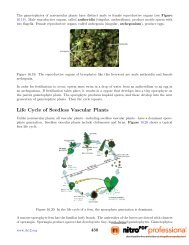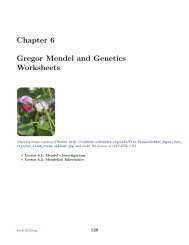Chapter 23 The Circulatory, Respiratory, Digestive, and Excretory ...
Chapter 23 The Circulatory, Respiratory, Digestive, and Excretory ...
Chapter 23 The Circulatory, Respiratory, Digestive, and Excretory ...
Create successful ePaper yourself
Turn your PDF publications into a flip-book with our unique Google optimized e-Paper software.
• macronutrient<br />
• mechanical digestion<br />
• micronutrient<br />
• mineral<br />
• MyPlate<br />
• MyPyramid<br />
• nutrient<br />
• obesity<br />
• peristalsis<br />
• small intestine<br />
• stomach<br />
• villi<br />
• vitamin<br />
Introduction<br />
<strong>The</strong> respiratory <strong>and</strong> circulatory systems work together to provide cells with the oxygen they need for<br />
cellular respiration. Cells also need glucose for cellular respiration. Glucose is a simple sugar that comes<br />
from the food we eat. To get glucose from food, digestion must occur. This process is carried out by the<br />
digestive system.<br />
Overview of the <strong>Digestive</strong> System<br />
<strong>The</strong> digestive system consists of organs that break down food <strong>and</strong> absorb nutrients such as glucose.<br />
Organs of the digestive system are shown in Figure <strong>23</strong>.18. Most of the organs make up the gastrointestinal<br />
tract. <strong>The</strong> rest of the organs are called accessory organs.<br />
(GI) system.<br />
<strong>The</strong> following interactive animation demonstrates the flow of food through the gastrointestinal<br />
<strong>The</strong> Gastrointestinal Tract<br />
<strong>The</strong> gastrointestinal (GI) tract is a long tube that connects the mouth with the anus. It is more than 9<br />
meters (30 feet) long in adults <strong>and</strong> includes the esophagus, stomach, <strong>and</strong> small <strong>and</strong> large intestines. Food<br />
enters the mouth, passes through the other organs of the GI tract, <strong>and</strong> then leaves the body through the<br />
anus. At the following link, you can watch an animation that shows what happens to food as it passes<br />
through the GI tract. http://www.youtube.com/watch?v=QtDgQjOGPJM.<br />
<strong>The</strong> organs of the GI tract are lined with mucous membranes that secrete digestive enzymes <strong>and</strong> absorb<br />
nutrients. <strong>The</strong> organs are also covered by layers of muscle that enable peristalsis. Peristalsis is an<br />
involuntary muscle contraction that moves rapidly along an organ like a wave (see Figure <strong>23</strong>.20). You can<br />
watch an animation of peristalsis at this link: http://en.wikipedia.org/wiki/File:Peristalsis.gif.<br />
www.ck12.org 706





